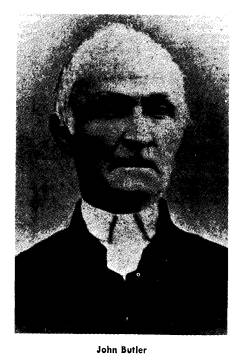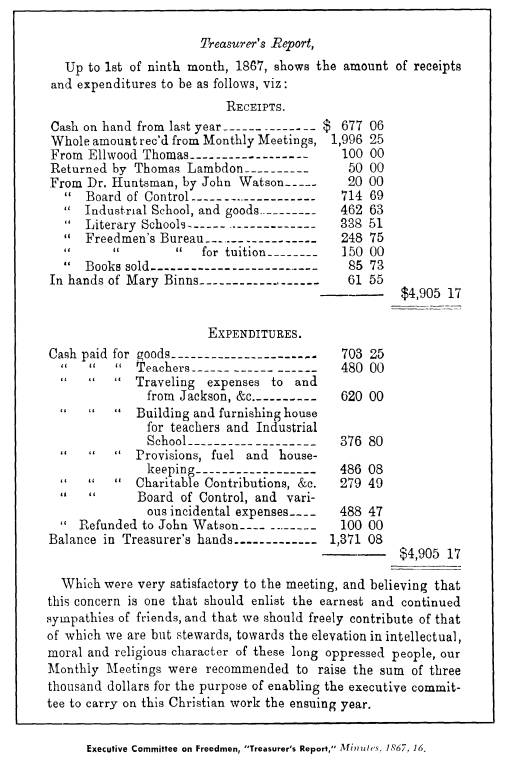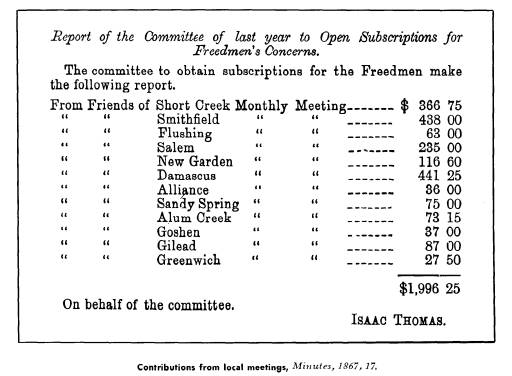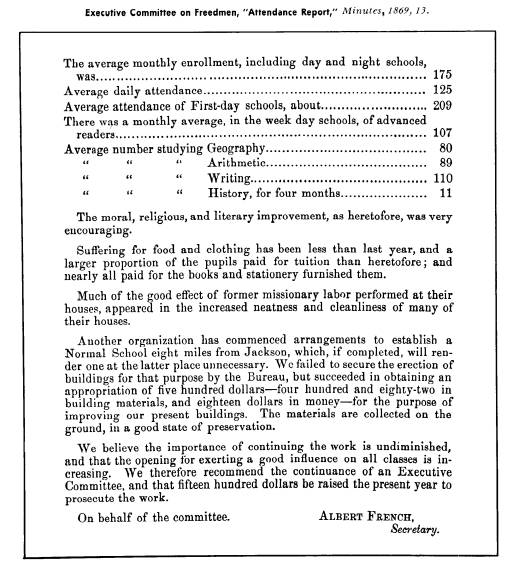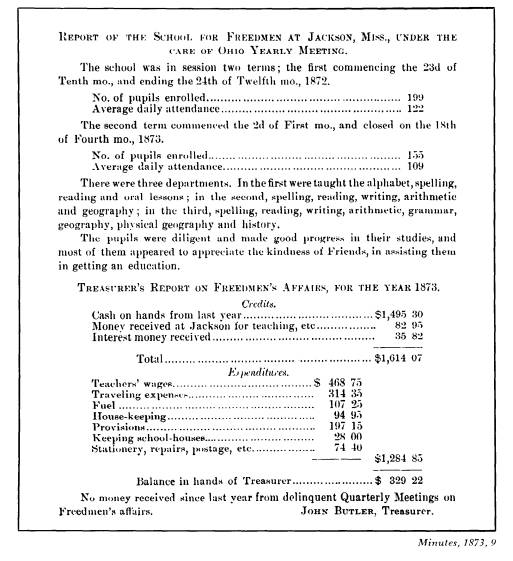Ohio History Journal
|
|
|
Ohio Quakers and the Mississippi Freedmen -- "A Field to Labor" by Thomas H. Smith |
|
During the American Civil War the Ohio Yearly Meeting of the Society of Friends (Orthodox) was one of several religious sects that found use of warfare to maintain national unity repugnant. The Friends, however, were not callous to the many sacrifices their neighbors had made, and they did not remain idle during time of national crisis. Instead of responding to the nation's martial needs, this small group applied its energy and financial resources to the education and rehabilitation of free black Ameri- cans. Their objectives were to prepare the former slaves for freedom and, at the same time, to make them useful and independent citizens within white society. It was in the area of Freedmen education and welfare that the Ohio Yearly Meeting found "a field . . . opened in which we are loudly called to labor."1 That the Ohio Friends were interested in the condition of the American Negro during and after the war was only natural since they had been long identified with those forces in the North that were dedicated to the abolition of slavery. For example, Benjamin Lundy, as early as 1815, had organized Ohio's Union Humane Society in St. Clairsville, and two years later Charles Osborn founded the antislavery newspaper, The Philanthro- pist, at Mt. Pleasant. Many Ohio Quakers had been active in assisting fugi- tive slaves on their trek across the state to freedom in Canada. On several occasions between 1825 and the outbreak of the war in 1861, Quakers had received small groups of manumitted slaves from the South and had provided for their settlement near their own communities.2 For these NOTES ON PAGE 221 |
160 OHIO HISTORY
persons and others already living in
Ohio, the Friends assisted in the
management of farms, provided for
educational and religious instruction,
distributed Bibles, furnished meeting
houses, and provided for the Negroes'
general well being. In fact, by 1859,
the Ohio Yearly Meeting was so
involved with the Negro that it created
a committee on the Concerns
of the People of Color and made it part
of its permanent organization.
Thus, by the eve of the Civil War the
Ohio Quakers had clearly committed
themselves to the welfare of Freedmen,
and although reports about these
Negroes were not always encouraging, the
Quakers observed that the
former slaves were "as susceptible
to improvement as any other class."3
Until 1863 efforts of Ohio Quakers on
behalf of the Freedmen had been
confined within the state, but after the
announcement of the Emancipa-
tion Proclamation, the Ohio Yearly
Meeting addressed itself to conditions
of Freedmen outside the state. This
outpouring of concern for the welfare
of the black "refugees" in the
South was not unique to tile Ohio Quakers,
but was part of a general movement of
the various Quaker yearly meetings
throughout the North, Mindful of their
refusal to aid the military, the
Quakers were willing to assist their
country during a period of national
strife by means consistent with their
beliefs.
Between 1863 and 1865 there was an
almost frantic effort on the part
of Ohio ers to relieve the physical
needs of the southern Negro. In
1863 several of the quarterly meetings
within the Ohio Yearly Meeting
contributed about $6000 in addition to
new and used clothing "for the
benefit of tile refugees from
slavery"4 to the Western Freedmen's Aid Com-
mission founded by the Western Yearly
Meeting that same year. This
commission was one of several such
agencies formed by northern Quakers
to aid suffering Freedmen in the South.
The following year the Ohioans
raised $6709.42 for tile relief of
Negroes and appointed a special committee
to coordinate its own efforts with those
of the Indiana, and Western and
Iowa yearly meetings.5 During
1864 and 1865 the Ohio special committee
spent much of its time collecting money
for direct relief work. It also
recommended to tile Yearly Meeting that
$10,000 should be raised through
voluntary subscriptions to aid "the sufferings of
these perishing people" and
suggested that twenty or more teachers
should be sent South to educate
the former slaves.6 In order to raise
this rather large sum of money, the
committee for the relief of Freedmen
sent circulars to each quarterly
and monthly meeting "encouraging
promptness and liberality in contribut-
ing to this benevolent cause."7
The argument was that,
The long oppressed and suffering
millions of tile South are loudly
calling on the friends of humanity for
help; . . . and upon the action
of the friends of justice and humanity
at this momentous period,
depends much of good or evil, not only
to this class, but to our country
and to the world. Then let us open
widely our hearts and purses, in
this dark hour of their trial; that in
the great day of final accounts, the
language may not be applied to us,
"Inasmuch as ye did not to one
of the least of these, ye did it not to
me."8
QUAKERS AND FREEDMEN
161
Apparently these appeals to the Quakers
were successful because most
of the $10,000 was collected. This
generous giving, however, marked the
high point for the Ohioan's direct
relief program. This type of relief
was understood to be a temporary
measure, and other more permanent
solutions were sought to improve the lot
of the southern blacks in the
post-Civil War years. The members were
told,
We wish to say for the encouragement to
those who contributed
to this benevolent cause, that, we
believe the experiment has fully
demonstrated that the quickest and
shortest way to relieve ourselves
of the burden of contributing to the
relief of this class, and the only
way to elevate them above the depressing
effects of the deeprooted
prejudice with which they are
surrounded, and enable them to enjoy
the full blessings of freedom is, after
relieving their pressing physical
wants, to educate.9
The Ohio Quakers were no doubt
influenced in their decision to turn
their energies toward the education of
the Negro during the winter of
1864-65 by the visit of their agent
Elder John Butler to various refugee
camps and Freedmen schools along the
Mississippi River. These facilities
had been established by the Indiana
Yearly Meeting under the leadership
of Levi Coffin. Since the Quakers
believed that the Federal Government
also had a definite responsibility for
caring for southern Freedmen, Butler
visited Washington to solicit Federal
aid. President Lincoln granted the
Ohioan an interview and expressed
"his thankfulness for what Friends
had done and were doing for the relief
of colored Freedmen."10 Butler
was successful in securing government
support for transportation for his
southern tour.
In November 1864, Butler and Elkanah
Beard, the agent for the Indiana
Yearly Meeting, together examined the
conditions and needs of Freedmen
in Mississippi. Beard, who was already
familiar with the situation in the
state suggested the Ohio Yearly Meeting
should establish a Freedmen's
school on Paw Paw Island, located near
Vicksburg, where there were ap-
proximately 550 destitute Negroes.
Perhaps because of the lateness of the
year or the unsettled political
condition in the state, the Ohio Quakers
were not interested in Mississippi at
that time but, instead, hired two
teachers to work in an Indiana Quaker
Freedmen's school in Nashville,
Tennessee.11
When Butler returned to Ohio on December
5, 1864, he was enthusiastic
about the Indiana Quakers' educational
activity among the southern blacks
and heartened by the progress of the
Negroes themselves. He reported to
the Ohio Yearly Meeting that the
Negroes' "desire to learn to read and
write is so great, and their whole mind
is so absorbed in it, that their
improvement in some instances has very
been [sic] remarkable."12 Butler
then suggested that "the moral and
intellectual mental culture and instruc-
tion in the general concerns of life,
would confer a more lasting benefit
upon these people, than merely relieving
their physical wants."13 Hence,
by the end of 1865, the Ohio Quakers
were convinced by both the apparent
162 OHIO HISTORY
success of the Indiana Yearly Meeting's
educational work in Tennessee
and Butler's report that they too should
become active in Freedmen educa-
tion, and they began looking for a
suitable location for a school.
Following their annual meeting in
September 1865, the Ohioans sent
their agent William Daniels to Tennessee
where Indiana Quakers already
had an interest. There, Daniels was
encouraged to begin work by the
Freedmen's Bureau which had been
established by the Federal Government
in March to care for former slaves.
However, due to such factors as com-
petition from other religious sects, a
widely scattered Negro population,
and hostilities of the whites toward any
kind of education for their former
slaves, Ohio's effort to found a
Freedmen's school in Tennessee was can-
celled. Still eager to be of service,
however, and with promise of aid from
the Freedmen's Bureau, the Ohio Quakers
hurried to Jackson, Mississippi,
in October when they heard of the need
for a school there. Reportedly,
there was "a good field for
Teachers and a disposition on the part of the
Freedmen to support the same themselves."14
The Friends at first encountered
resistance to their schools in Jackson
from
the local white population.15 It seems that, among other
things,
the southerners objected to the rather
large number of women included
in the group of immigrant teachers and
all sorts of fanciful stories were
circulated about Yankee schoolmarms. As
a matter of fact, of the five
Ohioans who opened the school in
Jackson, four were females. Just before
their arrival, a public meeting was held
to discuss the problem of female
teachers working with Negroes. It was
reported to the Freedmen's Bureau
that one speaker stated, "of 70
female teachers sent to Gen'l [Rufus]
Saxton's Dept., over 60 had illegitimate
colored children."16 It appears
that these accounts were mostly
fabrications, but, due to the suspicious
character of the local white population,
the Ohio teachers could not find
adequate housing, and the ladies were
forced to live together in one
room.
Even though the Friends encountered
opposition, some progress in their
work was reported. While the Quakers
waited for three small school build-
ings to be constructed on public land
provided by the Freedmen's Bureau,
the teachers conducted classes in a
nearby Negro church because no other
space was made available to them.
Elizabeth Bond, a teacher sent to assist
the Ohioans from the Indiana Yearly
Meeting, complained in a letter
that "nothing would induce them
[the southern whites] to give a room
which would be used for the Freedmen in
any way; so three of us are
teaching in the same room."17 Miss
Bond's letter indicated to the editor
of the Freedmen's Record that the
white people were determined "the
negro shall not be educated to work for
himself, but must at all events
be kept a degraded being, ready when the
time comes to be again converted
into a chattel. It is very
evident," the editor continued, "that they have
no idea of giving up slavery there, and
are only waiting for the Freedmen's
Bureau to be withdrawn, to openly
ensalve the negro population." But
Miss Bond reported that through the
efforts of the Quakers "the colored
QUAKERS AND FREEDMEN
163
people have raised money and bought
lumber to put up school houses"
for themselves.18 Also, John
H. Douglas, an agent for the Indiana Quakers
who toured Mississippi during the latter
part of 1865, stated that the
Ohio Quakers were "persevering
through obloquy and insult, but the
schools are in a flourishing
condition."19
That the southern Negro would be
educated eventually was one of the
consequences of the war; yet immediately
following the conflict, most
southern state legislatures had made no
provision for the education for
their former slaves, and this
responsibility thus fell upon northern philan-
thropy and the Negroes themselves. On
October 24, 1864, the Vicksburg
Herald explained to all northern teachers in the state,
whether they were
Congregationalists, Methodists,
Presbyterians, Baptists, or Quakers, the
former Confederate state was much too
poor to offer any aid.
It is well to speak plain--in the
present impoverished condition of
the country, the education of their own
children will doubtless draw
heavily on the resources of the
citizens. If any radical was ever black
enough in his views, to suppose the
people of Mississippi would endow
"negro schools," for their ilk
to teach the rising ebo-skin hatred of
his former master, but best friend; then
such chaps had better take
to marching on with John Brown's
soul--they will hardly reach the
object of their desires short of the
locality where John is kicking and
wailing. The State has not opened them,
nor has she the slightest idea
of doing anything of the kind. While the
adult blacks are leading
their present idle and unprofitable
life, shirking all regular employ-
ment, foraging on the outskirts of our
towns and cities, paying no taxes,
refusing to labor, in many instances,
for fair wages, to expect that the
whites should educate their children is
very cool and refreshing. The
sooner the free negro is taught that he
is to support himself and his
family, precisely as the white man does,
the better it will be for him
and his descendants. The white man will
not support him in idleness,
nor tax themselves for his benefit.20
Although it is certain that the white
citizens of Jackson distrusted what
they considered the radicalism of
northern teachers, the Friends were not
radical either in their approach or
objectives. The Quakers were con-
cerned with the conditions of the
southern Negroes to be sure, but theirs
was a Christian, not a political
concern. Because they were fellow human
beings, the Friends wanted to see the
lot of the Negroes improved, and
they believed that education would help
obtain this objective. Their ap-
proach was simplistic and closely
associated with their beliefs. Primarily,
education of the Freedmen was not to be
a burden on white society.
Whether in Ohio or in the South, former
slaves were encouraged to assume
the financial responsibility for their
education and livelihood. Second, the
curriculum established was one that
would free the Negroes from reliance
upon their former masters. Elementary
subjects along with some simple
manual skills were taught in order to
make the Freedmen self-sufficient
and thrifty. Third, Ohio Friends
employed the Lancastrian or monotorial
system which allowed more capable, older
black students to instruct younger
164 OHIO HISTORY
ones. This method permitted Quakers to
train Negro teachers quickly
and economically. Eventually, it was
hoped, enough Negro teachers would
be available for the former slaves to
assume the main responsibility of
educating their own people. Fourth, in
order to ensure the Freedmen the
opportunity to learn, Quakers encouraged
the teaching of their own
"guarded religious, and literary
education." This meant that they wanted
to shield the student from harmful
influences of wrong teaching and
textbooks while providing him with an
environment in which he could
learn. Consequently, it was the opinion
of the Ohio Yearly Meeting that
the southern black could best be helped
toward useful citizenship through
"counsel and encouragement . . .
and assistance in obtaining an educa-
tion," but that they must "by
their own efforts, aid and elevate them-
selves, . . . [rather than depend upon]
direct pecuniary relief; however
desirable this may be at
times."21
The school that was founded by the Ohio
Quakers in Jackson had both
a "School of Literary
Instruction" and an "Industrial School." Tile former
was concerned with teaching such
subjects as the alphabet, reading, geog-
raphy, arithmetic, and writing. The
report to the Educational Division
of the Freedmen's Bureau for November
1865 indicated that the literary
school had 134 students, of which forty
were pure African and the re-
mainder were of mixed blood. Also, of
the total, four were under six years
of age, eighty-eight between six and
sixteen, and forty-two over sixteen.22
The Negroes seemed responsive to
education,23 and, according to a report
sent to the 1866 Ohio Yearly Meeting,
"those who attend school seem
willing so far as able, to defray
expenses";24 that year the school collected
$629 for tuition and books from the
Freedmen.25
The industrial school taught women the
art of garment making, and
the sale of these clothing items helped
defray school expenses and provided
a small wage for the students. The
purpose of the wage was to give the
Negro practice in management of money as
well as to show whites that
former slaves could become financially responsible.
During 1866 the school
was open four months and enrolled an
average of forty-eight women daily.
These women worked approximately six
hours each day during the period
making 1267 garments and other articles.26
The industrial school, how-
ever, was short-lived. Apparently the
physical needs of the southern Freed-
men had lessened somewhat by 1867
because that year, after only thirty-
six days of operation, it was closed. At
about the same time, the Joint
Board of Relief, which had been formed
by the Ohio, Indiana, and
Western and Iowa yearly meetings in
1864, was dissolved because "the
circumstances [for its continuance were]
no longer existing."27 Thus, after
1867, the Ohio Friends concentrated more
of their energies on the
academic needs of Freedmen.
The Quakers labored hard among the
Freedmen in Jackson, and their
approach to the education of Negroes
soon calmed many fears the southern
white community had had about their
coming. Even though the Ohioans
had suffered some harrassment from the
white population, the Quakers
|
QUAKERS AND FREEDMEN 165 |
|
166 OHIO HISTORY |
|
soon reported that "the citizens . . . seem to be more kindly disposed," than they were before. "The meekness, patience and forbearance of the teachers seems to have had a favorable effect." The report continued, "and as citizens of Jackson remarked, the instruction given to the Freedmen, instead of making them saucy and indolent, has had a beneficial effect upon them, having a tendency to make them kind and obedient."28 Thomas Smith, ex-chaplain of the Fifty-Third United States Colored Troops and an official of the Freedmen's Bureau, expressed his thanks to the Ohio Yearly Meeting in the spring of 1866 for its work "in forming the intel- lectual, moral and religious character of the Freedmen." Smith, who point- ed out that the Friends had pioneered Negro education in Jackson, also said the Ohio teachers were "peaceable, unobtrusive and indefatigable" and that the school had "accomplished an invaluable amount of good."29 Yet, the Quakers realized more than did government officials the obstacles that lay ahead for the improvement of the general conditions of the southern Negroes. They confessed that while their work was one of "Christian love and self-sacrifice," its success was "not the work of a day, or a year, but many years."30 During the summer of 1866 the Quakers had to remove their school buildings from the public lands upon which the Freedmen's Bureau had helped them to settle, but the Ohio Yearly Meeting was able to purchase six town lots for their school.31 To fulfill the philosophy that the Freedmen should support their own education, a contract was drawn up between |
|
QUAKERS AND FREEDMEN 167 the Quakers and the Negroes which stated that when the Freedmen paid for the lots and houses and showed "sufficient ability to conduct their own schools, they are to own and have possession of the buildings and the lots on which they stand."32 The Quakers were still optimistic about their work with the Freedmen and reported that educational progress of the Negroes in Jackson was equal to that of white students in the North and that they were "generally inclined to try to help themselves."33 Even though the Quakers were encouraged by the progress of their school and the receipts remained adequate, by 1869 extraneous forces were causing them to re-evaluate their commitment. In 1868 the Mississippi "Black and Tan" constitutional convention, in which former slave-holders |
168 OHIO HISTORY
were a minority, accepted the concept of
public education. Furthermore,
many of the conservative elements in the
state accepted Negro education
as one of the consequences of the war.
For instance, the Jackson Daily
Clarion on several occasions called for some form of Negro
education
as long as it was controlled and
conducted by southern whites.34 Thus,
facing incipient state competition and
knowing that black teachers would
be needed in the newly created black
schools, the Quakers requested the
Freedmen's Bureau to establish a normal
or teachers' training school in
Jackson using the Friends' facilities.
In May 1868, Henry R. Pease, Super-
intendent of Education in Mississippi
for the Freedmen's Bureau, wrote
to Oliver 0. Howard, director of the
Bureau, in support of the idea of
a centralized normal school. Pease
explained that the Ohio Yearly Meet-
ing was anxious for the government to
take over its school.35 By September,
however, Pease reversed his opinion and
said the state governments should
provide for the education of Negroes.36
Although neither the state nor
the Freedmen's Bureau relieved the Ohio
Quakers of their teaching burden,
tile Bureau did donate $482 in building
materials and $18 in cash to the
school.37
In addition to political problems,
either because of the establishment
of a state-wide public education system
which provided for Negro educa-
tion as of July 1870 or because some
Quakers lost interest, each year after
1869 it was harder for the Ohio Yearly
Meeting to raise money to maintain
the school and harder still to get a
teaching staff for its operation. In
1871, however, state assistance did come
from Mississippi after the aid
received from the Freedmen's Bureau was
withdrawn. Because there were
not enough teachers to fill the
vacancies in the state's Negro schools,
the Hinds County Superintendent of
schools paid the tuition of the black
students and the salaries of the
teachers in the Quaker school, while the
"regulation and government of the
schools" remained in the hands of the
Quakers.38 This was only a
temporary arrangement, and the next year
the Ohioans lacked funds to open their
school. The Committee on Freed-
men for the Ohio Yearly Meeting thought,
however, that "the work
should not be abandoned at present, and
have made arrangements for
sustaining three teachers there the coming autumn and
winter."39
Their work was not abandoned, and the
Quakers opened the school
again in 1873. This year the Ohioans
faced opposition from both the
state school authorities and the local
white population. The state school
system, which had been created by a
Republican-dominated legislature,
was now under the control of Thomas W.
Cardoza, a Negro. To combat
the criticisms and unrest against the
new system, Cardoza turned to stronger
centralized control and was not
sympathetic with the Quaker's independent
efforts to give the blacks some form of
elementary education. The white
citizens of Jackson, too, were critical
of the Freedmen's school. Although
by 1873 the activities of the Ku Klux
Klan and other similar groups
against Negro schools in Mississippi had
subsided, the Quakers reported
to the Ohio Yearly Meeting that they had
faced "considerable opposition
|
QUAKERS AND FREEDMEN 169 from the authorities, and, to a considerable extent, from the public senti- ment of the white people of Jackson, it being asserted that our schools were an injury to the public schools, the children leaving the latter to attend the former."40 Evidently the Yearly Meeting itself was divided over the future of the Jackson endeavor. Even though the executive committee on Freedmen recommended that the school property in Jackson be sold and the proceeds be applied "to the education of the Freedmen at some other point,"41 other Quakers, at the same time, applied to the George Peabody Fund, which was dedicated to the growth and development of education in the South, for financial aid.42 The Peabody Fund, however, did not assist the Quakers. Thus, after almost a decade of work with the southern Freedmen, the Ohio Yearly Meeting was faced with failing financial support |
170 OHIO HISTORY
for the school and increasing local
white opposition. The future, indeed,
was not bright--the balance of funds on
hand at the end of 1873 being
only $329.22, down from an 1866-67
budget of $4905.17.43
The Quakers were able in some manner to
keep the school open for
two more drastically shortened terms
through 1874-75. As circumstances
grew worse, the Committee for the
Concerns of the People of Color in
its final report to the Ohio Yearly
Meeting explained that "in view of
the provisions made by the State of
Mississippi for the education of the
colored children, and the difficulty of
securing the funds necessary for
defraying the expenses of our school in
Jackson the Committee are united
in judgment that it is not best to
attempt to maintain a school there
the approaching winter."44 The
school never did open again under Quaker
jurisdiction, and in 1879 the
disposition of the property in Jackson, which
by that time was "considerably out
of repair," was committed to a small
committee headed by John Butler.
Butler's committee was to "sell, donate
or retain the property, as may best
accord with their judgment."45 It is
not clear what final disposition this
committee made of the Jackson
property since nothing was stated on the
subject in subsequent Yearly
Meeting reports. In any event, after
nearly ten years of work with the
Freedmen of Mississippi and expenditure
by 1875 of approximately
$27,557.60, the Ohio Quakers abandoned
their work in Jackson.46
Even though the Quakers' efforts with
the Freedmen were tapering
off, the Ohioans did not remain idle.
Coincidental with the later years
of the Freedmen's project, a great
outpouring of Quaker energy was directed
toward the cause of international peace,
national temperance, the advance-
ment of the Kickapoo and Pottawatomie
Indian tribes in Kansas, and to-
ward other home missionary activities.
The Ohio Yearly Meeting's work in
belalf of the Peace Association of
Friends in America, formed in 1867,
occupied the interests of Quakers for
nearly twenty years following the
Civil War. Their major emphasis was to argue
against the use of warfare
between Christian nations because the
resort to force to settle international
disputes was thought to be contrary to
the word of God. Ohioans were
asked to contribute $1000 to the
national association's first annual budget.47
In 1869, 618,337 pages of printed matter
concerning peace were distributed
from the association's printing office
in New Vienna, Ohio.48 Beginning in
1871 Ohio Quakers also tried to convince
their neighbors of the righteous-
ness of their own views on temperance
and circulated 80,000 pages of tem-
perance tracts, directed 95 temperance
meetings, established 22 juvenile
temperance societies in schools, and
conducted prayer meetings in 420 sa-
loons.49 Three years later
the Quakers intensified their temperance activity
and visited 526 families, saloons, and
individuals to convince those present
that the use of alcohol was ungodly.
They also disseminated 248,400 pages
of temperance literature.50 Interest in
the movement by the Ohio Yearly
Meeting continued throughout the remainder of
the nineteenth century.
Thus, by the last quarter of the
nineteenth century the Ohio Quakers
had put aside their concern for the
southern blacks and were looking
QUAKERS AND FREEDMEN
171
toward other fields in which to perform
their good works. As a pacifist
group the Quakers did not turn their
backs on their country during its
time of peril but addressed themselves
to problems that could be dealt
with in non-violent ways. Their labor
with the Freedmen in Jackson after
the war was a natural continuation of
their concern for the Negro which
they had witnessed long before the sectional
conflict. As a group, their
goals for the former slaves both in Ohio
and Mississippi were conservative.
They rarely spoke of social or civil
equality for the blacks but, consistent
with the consensus of northern educators
at that time and later popularized
by Booker T. Washington, the Quakers
wanted to make the Negroes
economically independent of white
society through academic and vocational
education. As the Friends themselves
explained:
Consistent members of our Society could
not conscientiously bear
"carnal weapons" even for the suppression of the Great Rebellion.
They dared not to imbrue their hands in
human blood. But let it
never be said that, in the contest with
the Slave Power, and in the need-
ful care of the suffering millions, who
were suddenly thrown as a
burden upon the government in the hour
of victory, they have not
nobly done their part.51
THE AUTHOR: Thomas H. Smith is
an assistant professor of history at
Ohio
University.
